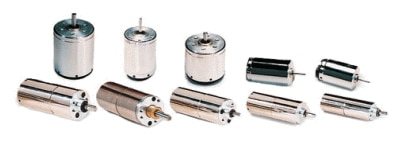The development of moving-coil or coreless motors dates back to the middle 1930s. But it wasn’t until the early 1960s that they were produced economically enough to gain wide acceptance.
Major advantages of coreless motors include very low inertia, low mechanical time constant, and high efficiency. Because the core is ironless, its low mass allows more rapid acceleration and deceleration than any other class of dc motor.
Other benefits gained by eliminating the iron core include the absence of magnetic fields acting on the laminations. This interaction in conventional motors appears as torque ripple or cogging plus a resisting torque that decreases motor efficiency. The absence of iron eliminates cogging and the coreless motor operates smoothly, even at low speeds.
Elimination of the iron core dramatically diminishes rotor inductance and resultant arcing. Commutator arcing in conventional motors is caused primarily by the release of stored energy in the armature inductance upon commutation. Excessive arcing produces electrical noise and reduces the life of brushes.
Coreless motors are classified by rotor shapes as cylindrical or disc. Cylindrical rotors are further divided into those containing inside fields or outside fields. The disc types have pancake, printed, or three-coil rotors.

The cylindrical outside-field motor has the smallest mechanical time constant. The stator is a cylindrical permanent magnet surrounded by a mild steel housing. The rotor is a hollow cylindrical coil wound of copper wire and located in the center of the stator. A mechanical time constant of 1 msec is not unusual for this type of motor.
Rotors are typically wound in a skewed or honeycomb pattern (also known as Faulhaber winding) to ensure that all of the core helps produce torque and smooth operation. The flux lines extend radially outward from the permanent-magnet stator through the air gap. The soft iron housing is the flux return path which allows the air gap to be extremely small, producing a high flux density.
The cylindrical inside-field motor is a similar design, but the permanent-magnet stator is located inside the hollow rotor. The motor also features a low moment of inertia, but the mechanical time constant is typically higher than the outside-field motor because of smaller stator magnets.
Coreless motor commutators and brushes are typically small, primarily because they are made of precious metals — gold, silver, platinum, or palladium. In addition, a smaller commutator has lower peripheral speed, less wear, and accounts for a smaller motor.
Outside-field motors are usually selected for high acceleration. Because of this, the rotor coils must handle a large load torque and dissipate high heat produced by peak currents. To handle the torque, manufacturers strengthen the rotor with glass epoxy. Since the rotor does not have an iron core to act as a heat sink, the housing has ports for forced air cooling.
Recent advances in coreless motor design include the replacement of AlNiCo with samarium-cobalt stator magnets. Also, the mechanical time constant is reduced by as much as two times with aluminum rotor wire instead of copper.
Typical accelerations for these improved motors are 150,000 rad/sec2, but rates up to 1 million rad/sec2 are possible. This greatly exceeds the 30,000 to 50,000 rad/sec2 rates available with iron-core rotor servomotors.
Sinotech Motors can ensure excellent Coreless DC Motors from China, Taiwan and Korea and is very price competitive. Sinotech Motors has manufactured QS-9000 and ISO certified Coreless DC Motors in China, Taiwan and Korea for over 15 years. Sinotech Motors is dedicated to delivering coreless motors from China, Taiwan and Korea to you at lower prices but the same quality, service and terms as a domestic supplier.
Sinotech Coreless Motors are engineered in the U.S. and manufactured in China, Taiwan and Korea.
